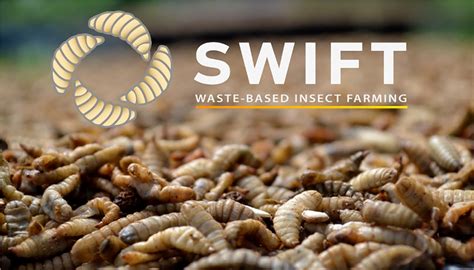Insect farming, a rapidly evolving field, has emerged as a promising solution to meet the burgeoning global demand for food and sustainable protein sources. This article delves into the transformative technologies and innovations that are shaping the future of insect farming, exploring their potential to revolutionize the industry.

The Rise of Insect Farming
The global population is projected to reach 9.7 billion by 2050, putting immense pressure on food systems. Insect farming offers a sustainable alternative to traditional livestock production, requiring significantly less land, water, and feed. Insects are highly efficient converters of organic matter, making them an environmentally friendly source of protein. According to the United Nations Food and Agriculture Organization (FAO), insects emit up to 100 times less greenhouse gases than cattle.
Technological Advancements
1. Automated Harvesting Systems
Traditionally, insect harvesting was a labor-intensive process, limiting scalability. However, automated harvesting systems have revolutionized the industry. These systems use advanced sensors, robotics, and AI to efficiently collect and sort insects. They minimize labor costs, increase productivity, and ensure a consistent supply of high-quality insects.
2. Artificial Intelligence (AI)
AI plays a vital role in insect farming, optimizing growth conditions and improving efficiency. AI-powered algorithms analyze data from sensors and cameras to monitor insect health, adjust environmental parameters, and predict optimal harvesting times. This automation streamlines operations and reduces human error.
3. Vertical Farming
Vertical farming techniques allow insects to be raised in stacked layers within controlled environments. This approach maximizes space utilization, reduces water consumption, and enables year-round production. Vertical farms use LED lighting, automated irrigation systems, and advanced monitoring technology to optimize insect growth and yield.
Innovation in Applications
1. Food and Feed
Insects are a nutrient-rich food source, containing protein, fats, and minerals. They are increasingly incorporated into human and animal diets in the form of protein powder, flour, and whole insects. The growing demand for sustainable protein is driving innovation in insect processing technologies, such as extrusion and drying.
2. Pharmaceuticals and Cosmetics
Insect-derived compounds have unique medicinal properties. For example, chitin, a polysaccharide found in insect exoskeletons, has applications in wound healing, drug delivery systems, and cosmetics. Research is also exploring the use of insect secretions and extracts in the development of new pharmaceuticals.
3. Waste Management
Insects play a crucial role in waste management. Black soldier fly larvae can efficiently convert organic waste, such as food scraps, into high-quality compost. This innovation reduces landfill waste, promotes soil health, and creates a circular economy.
Market Insights
The global insect farming market is experiencing significant growth, driven by increasing demand for sustainable protein and the adoption of advanced technologies. According to Allied Market Research, the market is projected to reach $1.4 billion by 2025, registering a CAGR of 25.6%. The Asia-Pacific region is expected to dominate the market, with China and India leading the growth.
Benefits of Insect Farming Technology and Innovation
1. Increased Productivity
Automated harvesting systems and AI optimization enable higher yields and faster turnaround times, ensuring a consistent supply of insects. Innovations in vertical farming maximize space and reduce water usage, increasing overall productivity.
2. Reduced Costs
Automation and AI minimize labor costs and reduce operational expenses. Moreover, insect farming’s efficiency and low environmental impact can lead to substantial cost savings compared to traditional livestock production.
3. Improved Sustainability
Insect farming requires significantly less land, water, and feed than traditional livestock. The use of organic waste for feed reduces environmental pollution and promotes circularity. Additionally, insect production emits fewer greenhouse gases, contributing to climate change mitigation.
FAQs
1. Is insect farming safe for human consumption?
Yes, insects are a nutritious and safe food for humans. The FAO has established guidelines for the production and consumption of insects to ensure their safety and quality.
2. How does insect farming compare to traditional livestock production?
Insect farming requires significantly less land, water, and feed than traditional livestock production. Insects have a higher feed conversion ratio, meaning they produce more protein per unit of feed. Additionally, insect farming has a lower environmental impact and emits fewer greenhouse gases.
3. What are the challenges facing insect farming?
The insect farming industry is still in its early stages of development and faces challenges such as consumer acceptance, regulatory frameworks, and the need for further research and innovation.
4. What is the future of insect farming?
Insect farming is expected to continue to grow rapidly in the coming years. Advanced technologies and innovations will play a crucial role in scaling up production, improving sustainability, and expanding applications.
Reviews
1. “Insect farming has the potential to revolutionize our food system by providing a sustainable and nutritious alternative to traditional protein sources.” – Dr. Arnold van Huis, FAO
2. “Automation and AI are transformative technologies that are enabling insect farming to become more efficient, scalable, and cost-effective.” – John Anderson, CEO, Aspire Food Group
3. “Vertical farming is a game-changer for insect farming, allowing us to maximize space and control environmental conditions to optimize insect growth.” – Martha Stewart, CEO, Buggaroo
4. “Insect farming is not just about producing protein; it also offers innovative solutions for waste management and the development of new pharmaceuticals.” – Professor John Paoletti, University of Massachusetts Amherst
Conclusion
Insect farming technology and innovation are rapidly advancing, paving the way for a sustainable and efficient food system. By embracing automation, AI, and vertical farming, the industry is unlocking new opportunities for insect production, applications, and environmental benefits. As the world grapples with the challenges of feeding a growing population and mitigating climate change, insect farming stands poised to play a pivotal role in shaping the future of food and sustainability.





















